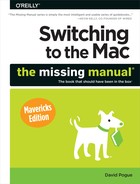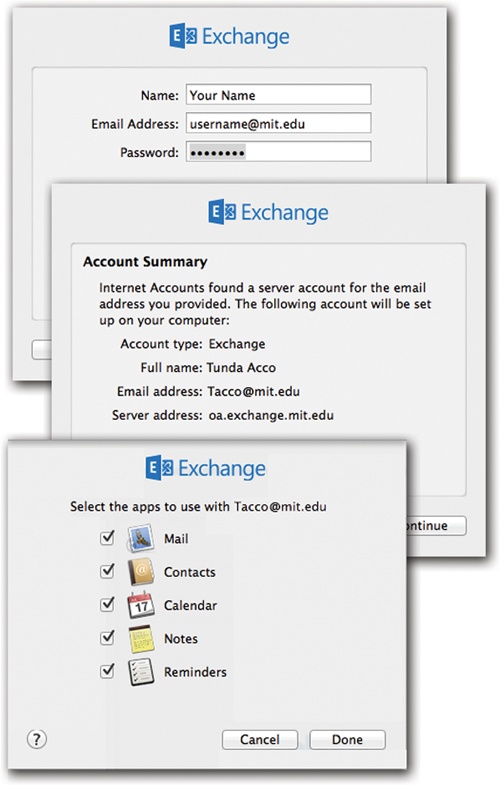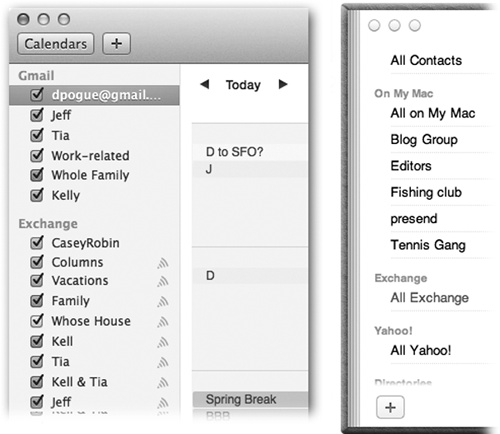 Life with Microsoft Exchange
by David Pogue
Switching to the Mac: The Missing Manual, Mavericks Edition
Life with Microsoft Exchange
by David Pogue
Switching to the Mac: The Missing Manual, Mavericks Edition
- Switching to the Mac: The Missing Manual, Mavericks Edition
- The Missing Credits
- Introduction
- One. Welcome to Macintosh
- 1. How the Mac Is Different
- 2. Folders, Dock & Windows
- Renaming Icons
- Selecting Icons
- Moving and Copying Icons
- Aliases: Icons in Two Places at Once
- Finder Tags
- The Trash
- Get Info
- Shortcut Menus, Action Menus
- The Spotlight Menu
- The Spotlight Window
- Customizing Spotlight
- Smart Folders
- 4. Documents, Programs & Mission Control
- The Mac App Store
- Other Ways to Get Mac Software
- Opening OS X Programs
- Launchpad
- Windows That Auto-Reopen
- The “Heads-Up” Program Switcher
- Full Screen Mode
- Mission Control: Death to Window Clutter
- Dashboard
- Exposé
- Hiding Programs the Old-Fashioned Way
- How Documents Know Their Parents
- Keyboard Control
- The Save and Open Dialog Boxes
- Auto Save and Versions
- Documents in the Cloud
- 5. Entering, Moving & Backing Up Data
- Two. Making the Move
- 6. Transferring Your Files to the Mac
- 7. Special Software, Special Problems
- ACDSee
- Acrobat Reader
- ACT
- Ad Subtract (Pop-Up Stopper)
- Adobe [your favorite program here]
- AOL
- AIM (AOL Instant Messenger)
- Children’s Software
- Chrome
- Easy CD Creator
- Encarta
- Eudora
- Excel
- Firefox
- Games
- Google Desktop Search
- Google Earth
- Google Chrome
- ICQ
- Internet Explorer
- iTunes
- McAfee VirusScan
- Microsoft Access
- Microsoft Money
- Microsoft Office
- Microsoft Publisher
- Microsoft Visio
- Minesweeper
- MSN Messenger
- NaturallySpeaking
- Netscape
- Newsgroup Readers
- Norton AntiVirus
- Norton Utilities
- Notepad
- Outlook/Outlook Express/Windows Mail
- PaintShop Pro
- Picasa
- PowerPoint
- QuickBooks
- Quicken
- RealPlayer
- RssReader
- Skype
- Snagit (Screenshots)
- Solitaire
- Street Atlas USA
- TaxCut, TurboTax
- Winamp, MusicMatch
- Windows Media Player
- WinZip
- Word
- WordPerfect
- Yahoo Messenger
- 8. Windows on Macintosh
- 9. Hardware on the Mac
- Mac Meets Printer
- Making the Printout
- Managing Printouts
- Printer Sharing
- Faxing
- PDF Files
- Fonts—and Font Book
- Digital Cameras
- Disks
- Startup Disks
- Erasing a Disk
- Burning CDs and DVDs
- iTunes: The Digital Jukebox
- DVD Movies
- AirPlay
- Keyboards
- Mouse
- Monitors
- Scanners
- Three. Mavericks Online
- 10. Internet Setup & iCloud
- 11. Mail & Contacts
- Checking Your Mail
- Tailoring the Look of Mail
- Writing Messages
- Reading Email
- VIPs
- The Anti-Spam Toolkit
- Contacts (Address Book)
- 12. Safari
- 13. Messages
- Four. Putting Down Roots
- 14. Accounts, Security & Gatekeeper
- 15. Networking, File Sharing & Screen Sharing
- 16. System Preferences
- The System Preferences Window
- Accessibility
- App Store
- Bluetooth
- CDs & DVDs
- Date & Time
- Desktop & Screen Saver
- Dictation & Speech
- Displays
- Dock
- Energy Saver
- General
- iCloud
- Internet Accounts
- Keyboard
- Language & Region
- Mission Control
- Mouse
- Network
- Notifications
- Parental Controls
- Printers & Scanners
- Security & Privacy
- Sharing
- Sound
- Spotlight
- Startup Disk
- Time Machine
- Trackpad
- Users & Groups
- 17. Notifications
- 18. The Freebie Programs
- Your Free OS X Programs
- App Store
- Automator
- Calculator
- Calendar
- Chess
- Contacts
- Dashboard
- Dictionary
- DVD Player
- FaceTime
- Font Book
- Game Center
- GarageBand
- iBooks
- Image Capture
- iMovie, iPhoto
- iTunes
- Launchpad
- Maps
- Messages
- Mission Control
- Notes
- Photo Booth
- Preview
- QuickTime Player
- Reminders
- Safari
- Stickies
- System Preferences
- TextEdit
- Time Machine
- Utilities: Your OS X Toolbox
- Activity Monitor
- AirPort Utility
- AppleScript Editor
- Audio MIDI Setup
- Bluetooth File Exchange
- Boot Camp Assistant
- ColorSync Utility
- Console
- DigitalColor Meter
- Disk Utility
- Grab
- Grapher
- Java Preferences
- Keychain Access
- Migration Assistant
- Network Utility
- RAID Utility
- System Information
- Terminal
- VoiceOver Utility
- Five. Appendixes
- A. Installation
- B. Troubleshooting
- C. The “Where’d It Go?” Dictionary
- About [this program]
- About [this program]
- Accessibility Options control panel
- Active Desktop
- Add Hardware control panel
- Add or Remove Programs
- All Programs
- Alt key
- Automatic Update
- Backspace key
- Battery level
- BIOS
- Briefcase
- Calculator
- Camera and Scanner Wizard
- CDs and DVDs
- Character Map
- Clean Install
- Clipboard
- Command line
- Control Panel
- Copy, Cut, Paste
- Ctrl key
- Date and Time
- Delete Key (Forward Delete)
- Desktop
- Directories
- Disk Defragmenter
- Disks
- Display control panel
- DLL files
- DOS prompt
- Drivers
- End Task dialog box
- Exiting programs
- Explorer
- Favorites
- Faxing
- File Sharing
- Floppy disks
- Folder Options
- Fonts
- Help and Support
- Hibernation
- Internet Explorer
- Internet Options
- IRQs
- Java
- Keyboard control panel
- Logging in
- Mail control panel
- Maximize button
- Menus
- Minimize button
- Mouse control panel
- (My) Computer
- (My) Documents, (My) Pictures, (My) Music
- (My) Network Places
- Network Neighborhood
- Notepad
- Phone and Modem Options control panel
- Power Options
- Printer Sharing
- Printers and Faxes
- PrntScrn key
- Program Files folder
- Properties dialog box
- Recycle Bin
- Regional and Language Options control panel
- Registry
- Run command
- Safe Mode
- ScanDisk
- Scheduled Tasks
- Scrap files
- Screen saver
- Search
- Shortcut menus
- Shortcuts
- Sounds and Audio Devices
- Speech control panel
- Standby mode
- Start menu
- StartUp folder
- System control panel
- System Tray
- Taskbar
- Taskbar and Start Menu control panel
- “Three-fingered salute”
- ToolTips
- Tweak UI
- User Accounts control panel
- Windows (or WINNT) folder
- Windows logo key
- Windows Media Player
- Windows Messenger
- WordPad
- .zip files
- About [this program]
- D. The Master OS X Keystroke List
- Index
- About the Author
- Colophon
- Copyright
In the corporate world, Microsoft Exchange is the 800-pound gorilla. It’s the networking software that runs the email, address books, and calendars for hundreds or thousands of employees. All of this communicates with a central master database whose heart beats away in some closet or back room at your company’s headquarters.
For years, Macs have been second-class citizens in Corporate America. As long as they couldn’t talk to the Exchange brain, they weren’t much use outside the graphic-design department. (You could buy add-on software or muck with workarounds, but you always felt like a weirdo.)
Now, however, Exchange compatibility is built in. In the Mac’s Calendar, your company’s Exchange calendar shows up. In Contacts, your company’s names and addresses show up. In Mail, you can get all your corporate email. Best of all, this information shows up side by side with your own personal data, so you can have it all in one place. All the conveniences of OS X now apply to your corporate email: Spotlight, Quick Look, data detectors, and so on.
GEM IN THE ROUGH: Delegating Your Calendars
Once you’re all Exchanged up, you can even delegate your calendar—that is, permit someone else on your corporate network to see (and, if you wish, edit) your calendar from across the network. That’s handy when you’re a busy executive and you want your personal assistant to help you manage your busy life, or when you’re going to be out of town and you’ve authorized a trusted minion to carry on with your calendar in your absence.
(This is not the same as publishing your calendar as described on “Publishing” Calendars to the Web. Your Exchange calendar isn’t actually going to move. It’ll sit right there on the server—you’re just giving someone else access to it.)
To set this up, choose Calendar→Preferences→Accounts. (If you have more than one account, choose the one you want to share from the Accounts list.)
Click Delegation. Click Edit. On the Manage Account Access screen, click ![]() , and type the name of the person you want to share your calendar with. You can also specify how much access you want that person to have; Read Only means they can just see your life, and Read & Write means they can actually edit it. You can grant different levels of access to your calendar and your Tasks list.
, and type the name of the person you want to share your calendar with. You can also specify how much access you want that person to have; Read Only means they can just see your life, and Read & Write means they can actually edit it. You can grant different levels of access to your calendar and your Tasks list.
Finally, click Done.
Now change hats. Suppose you’re the trusted assistant.
On your Mac, choose Calendar→Preferences→Accounts. You’ll find the account that’s been shared with you on “Delegation – Accounts I can access.”
Finally, turn on the Show checkbox. Close the Preferences dialog box to return to the main Calendar display. Here your boss’s calendars (appointment categories) show up in the left-side list; turn on the checkboxes of the ones you want to appear on the calendar grid.
If your company is using Exchange 2007 or later (Service Pack 1, Update Rollup 4 and later), setting this up could not be easier.
To connect to your company’s Exchange system, open System Preferences→Internet Accounts. Click the big Microsoft Exchange button, and then proceed as shown in Figure 8-4.
Figure 8-4. Top: In System Preferences, fill in your Exchange information—your email address and password—as provided by your cheerful network administrator. Middle: If you entered your information correctly and your Exchange server recognized you, then this box appears, summarizing the Mac’s understanding of your Exchange account. You’re all set. If your Mac doesn’t find the server, then either (a) your company doesn’t use Exchange 2007 or later, or (b) your network geek hasn’t turned on Exchange Autodiscover. In that case, you have no choice but to call that person over to your desk and either (a) harangue him for not turning on Autodiscover, or (b) have him fill in the server address and other boxes by hand. Bottom: Which elements of your Exchange account do you want your Mac to display? If you choose Mail, for example, then your Mail app will display your Exchange email account. Contacts, Calendars, Notes, and Reminders will all show Exchange’s information as specially identified accounts, which you can hide or show with one click.
Now one of two things happens:
Once everything is set up, open Mail. If you have a lot of mail, it may take time for Mail to synchronize with the Exchange server and display your messages. But it gets there eventually. Your Exchange account appears with its own heading, beneath your personal accounts (Figure 8-5, right).
Figure 8-5. Once everything is hooked up, a new heading appears in Mail, Calendar (left), and Contacts (right), named after your Exchange account. That’s your corporate life, which you can hide and show at will.
Now you can send and receive email, create notes and to-do items, respond to emailed invitations, and so on. All the Mail features described in Chapter 11 are ready to go: Spotlight can search all your accounts simultaneously, Smart Folders can round up messages from one account or all of them, Quick Look can show you attachments without your having to open them in a separate program, and so on.
Your corporate appointments now show up in the Mac’s calendar (Calendar), neatly filed under their own heading in the Calendars list (Figure 8-5).
And in Contacts, your company’s Global Address Lists show up as a group in the Groups list, as shown at right in Figure 8-5.
-
No Comment

